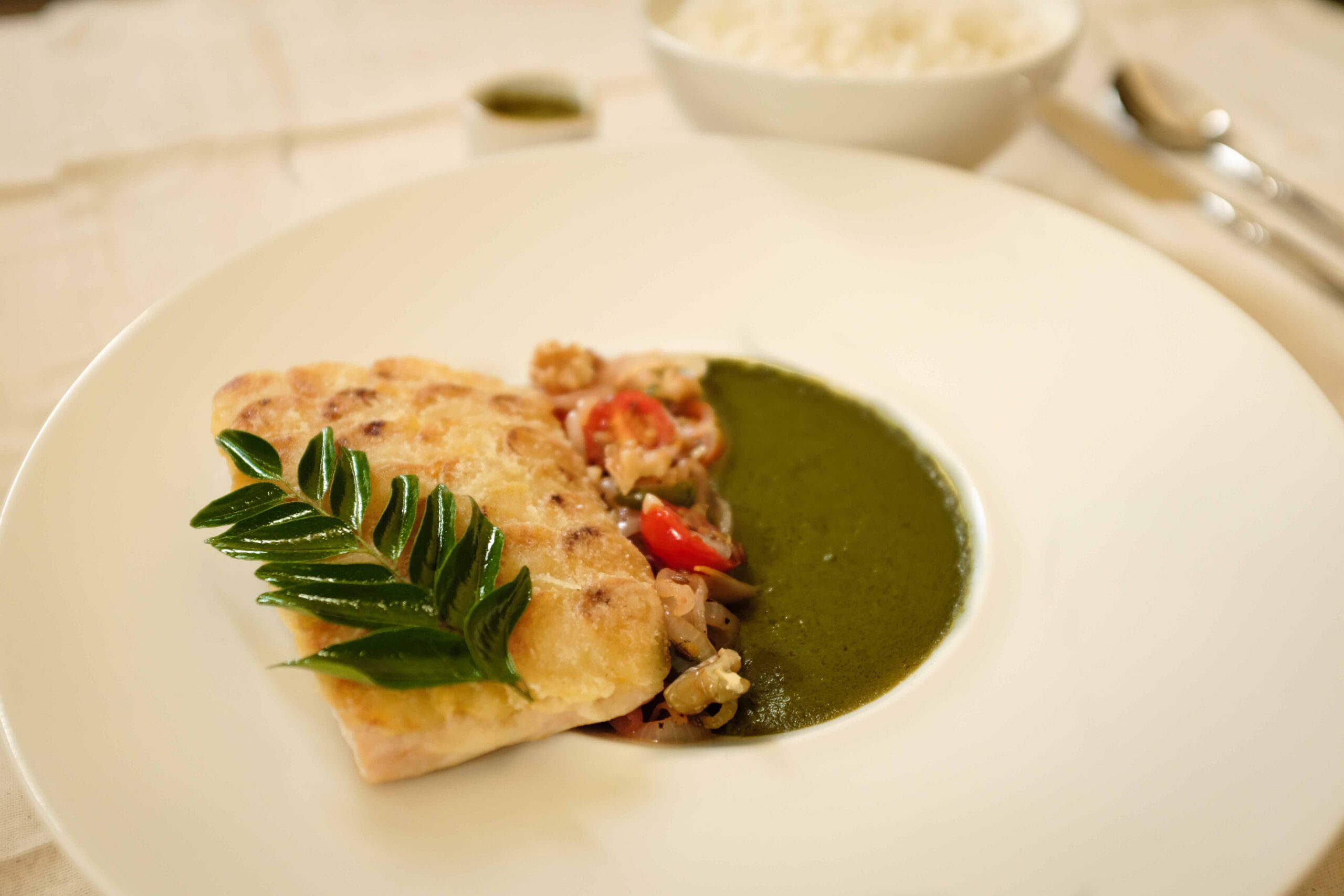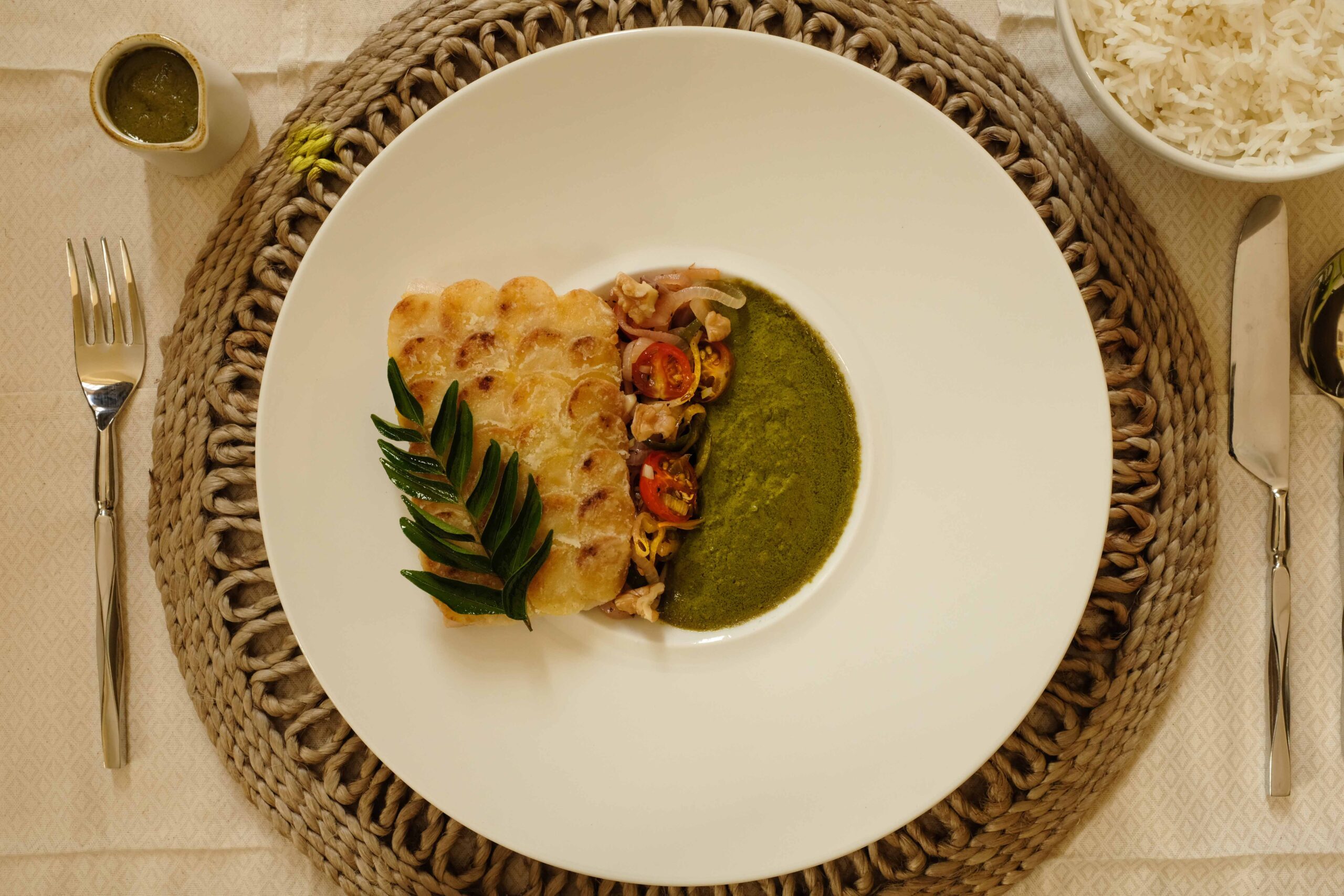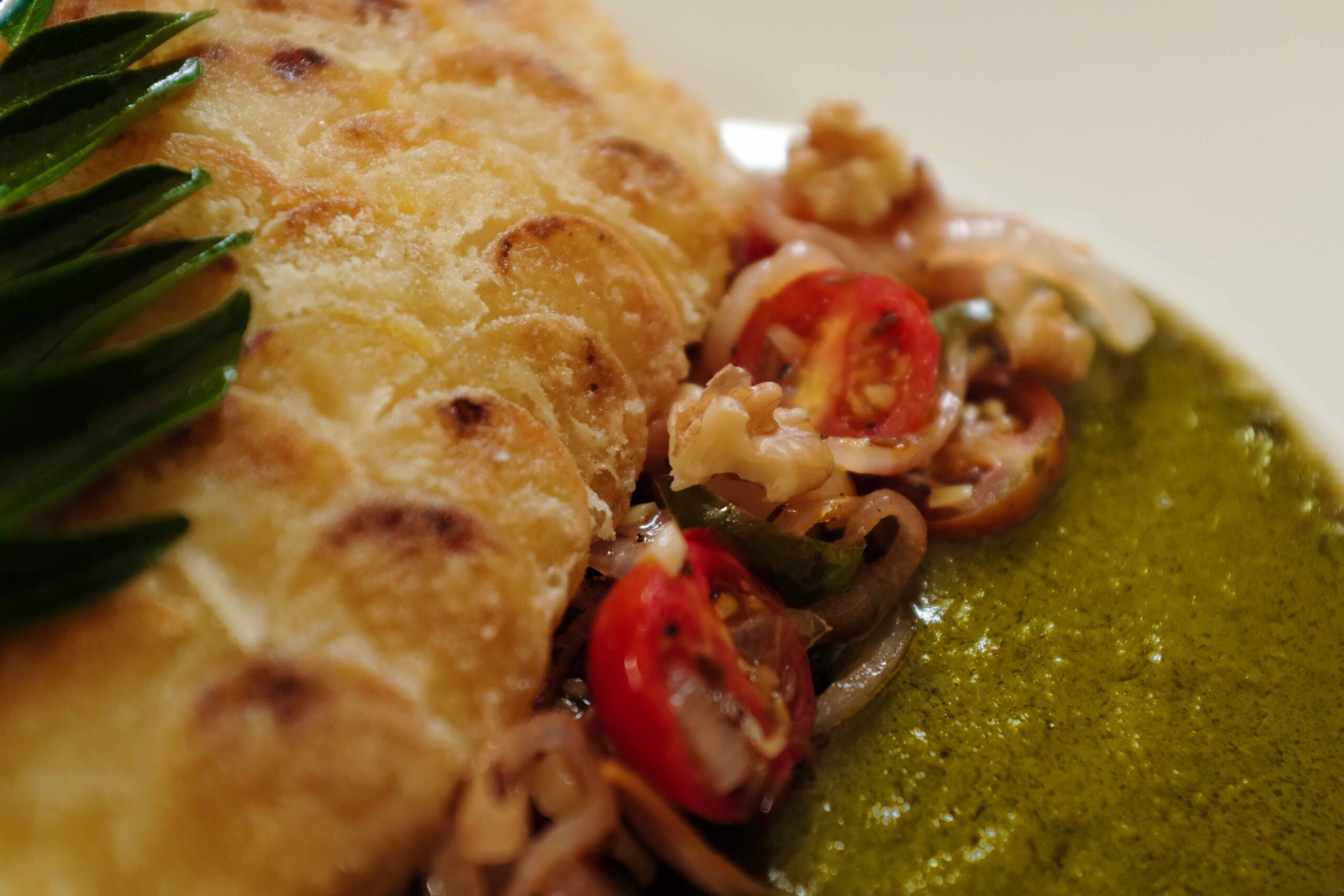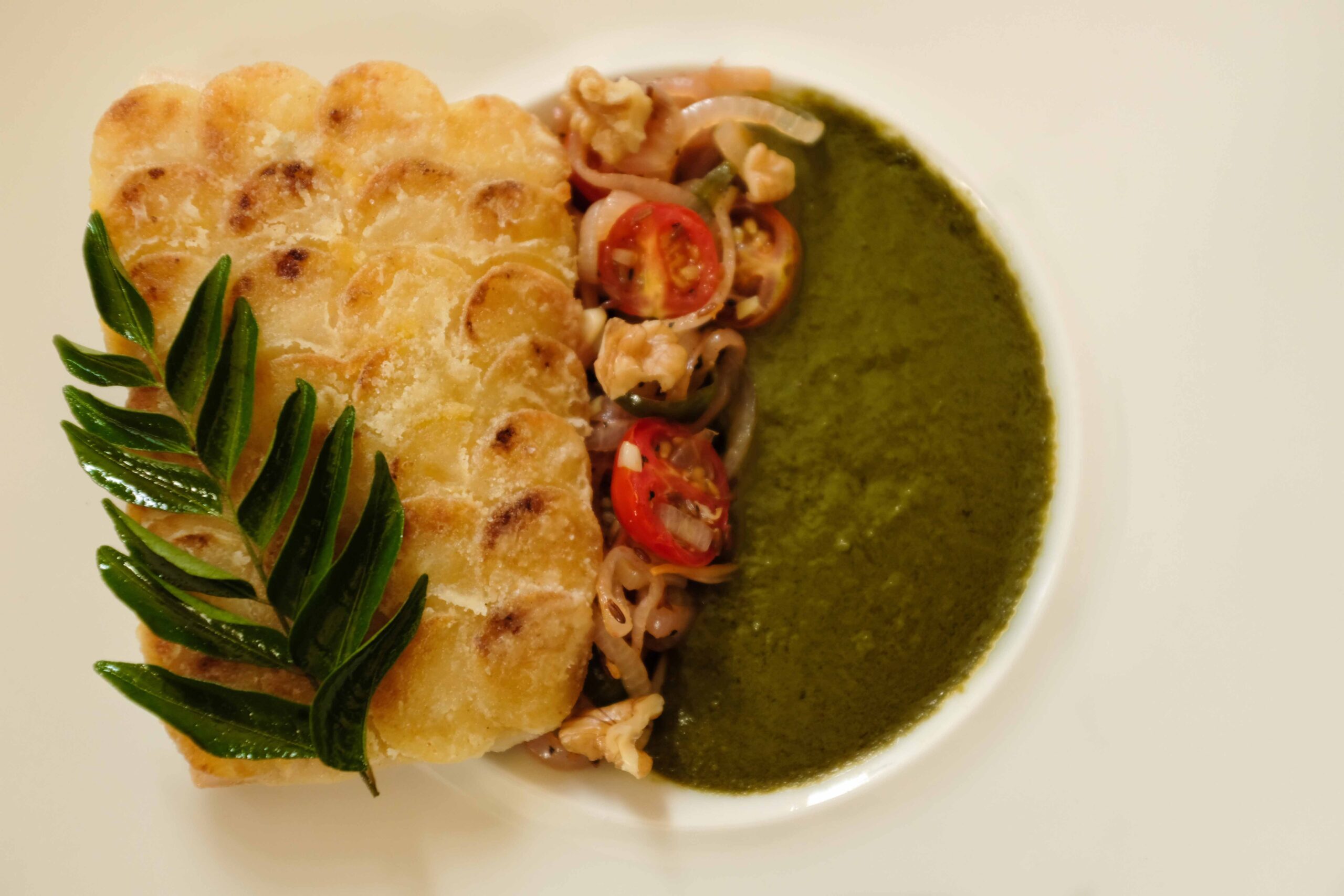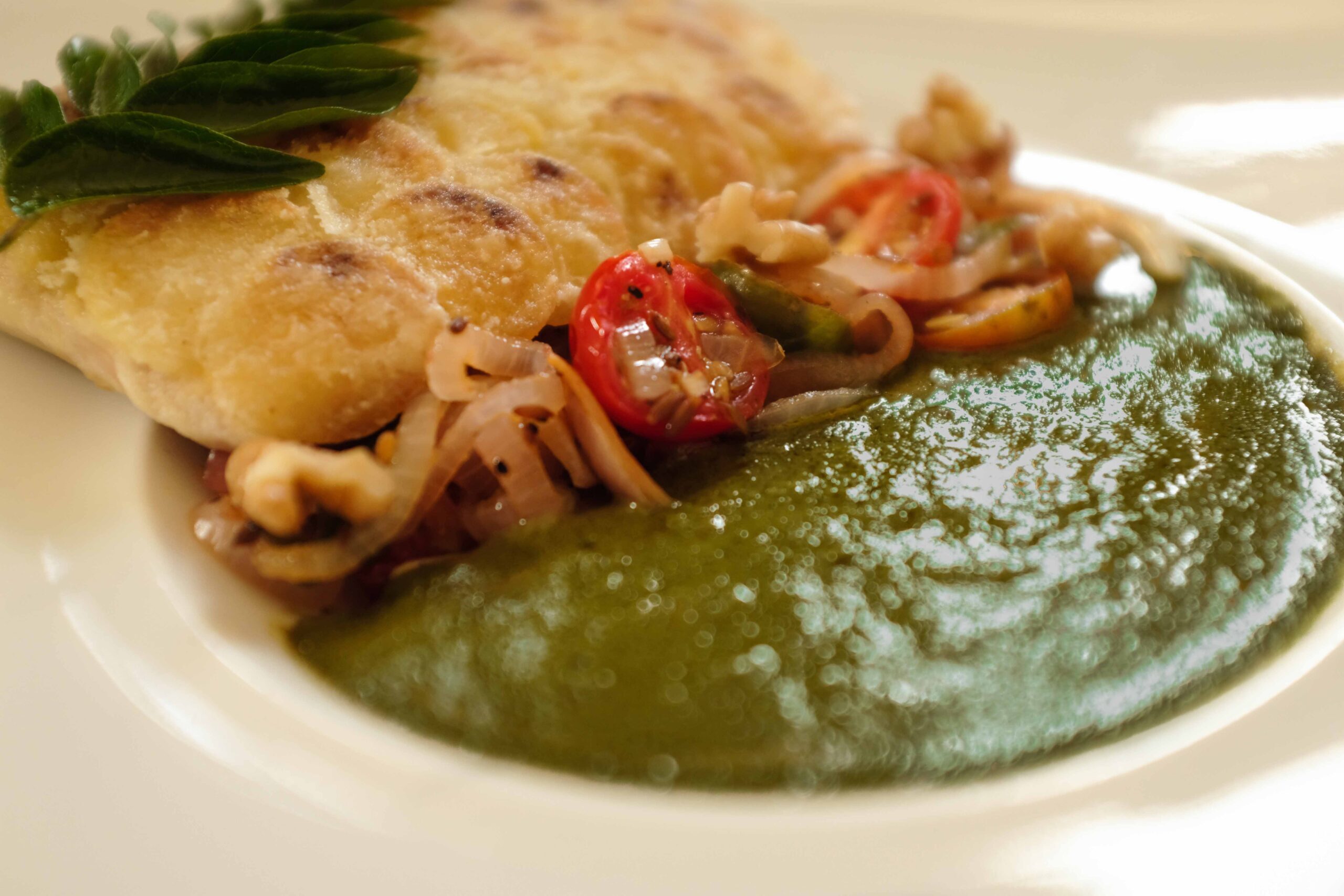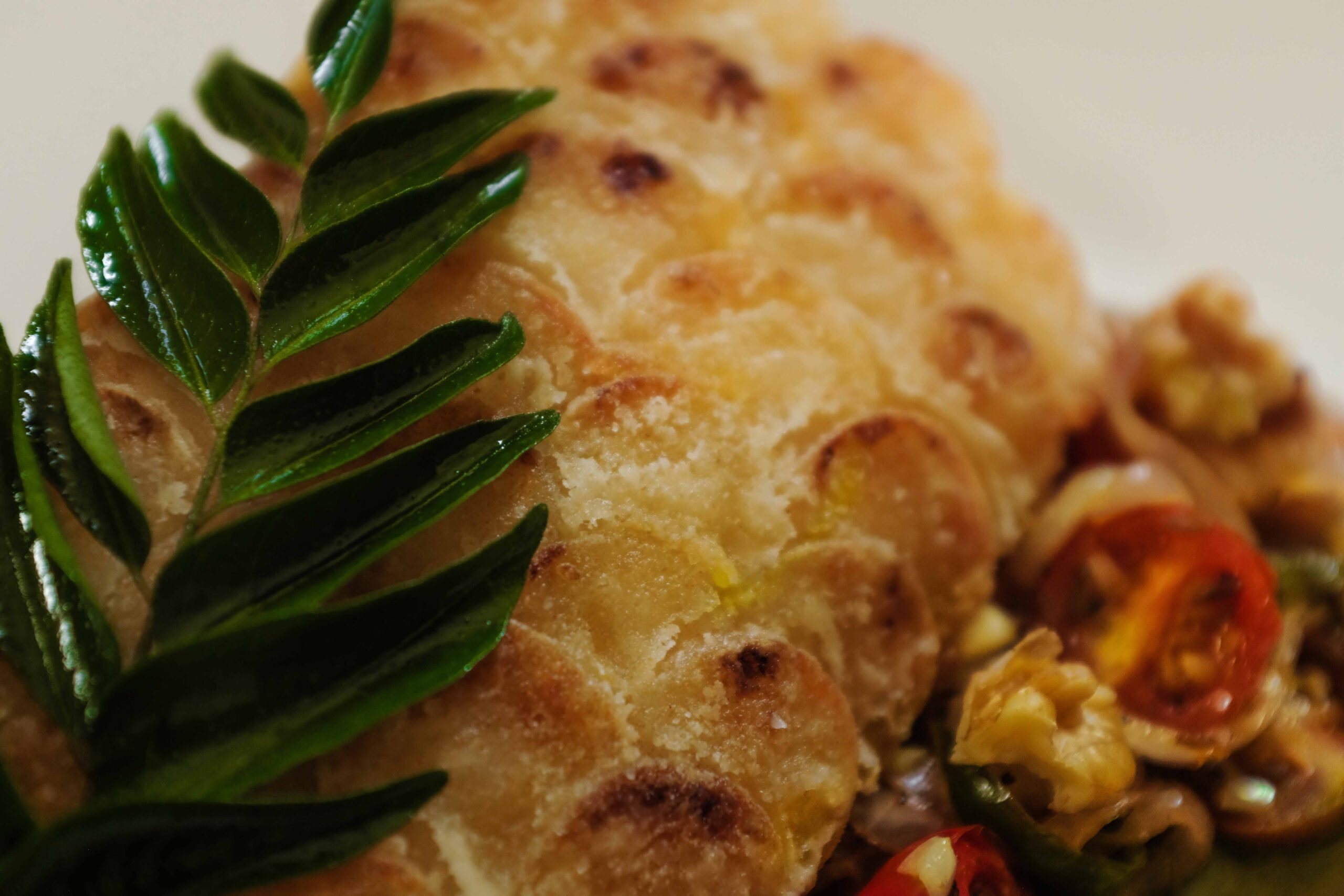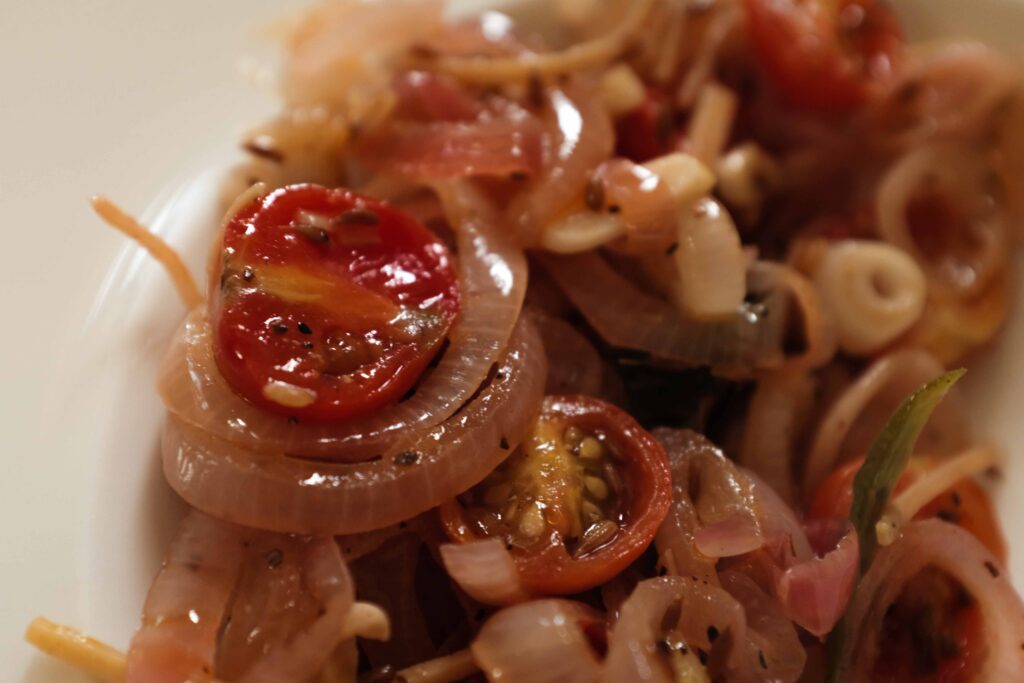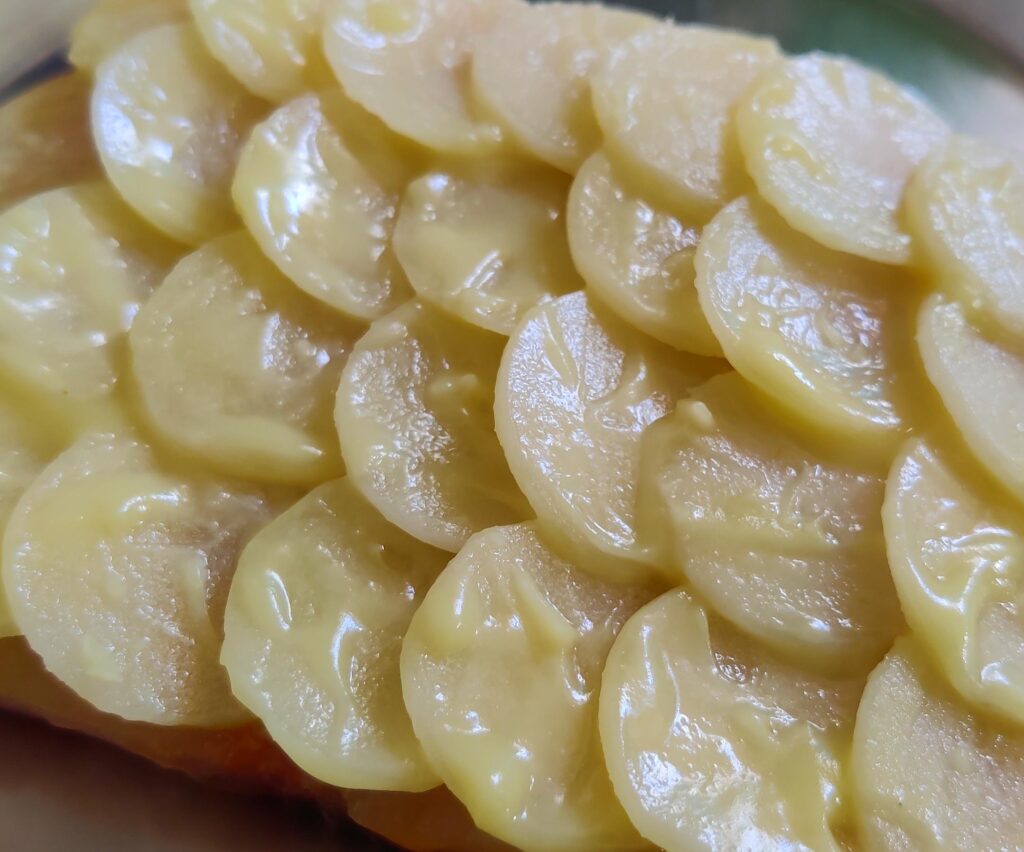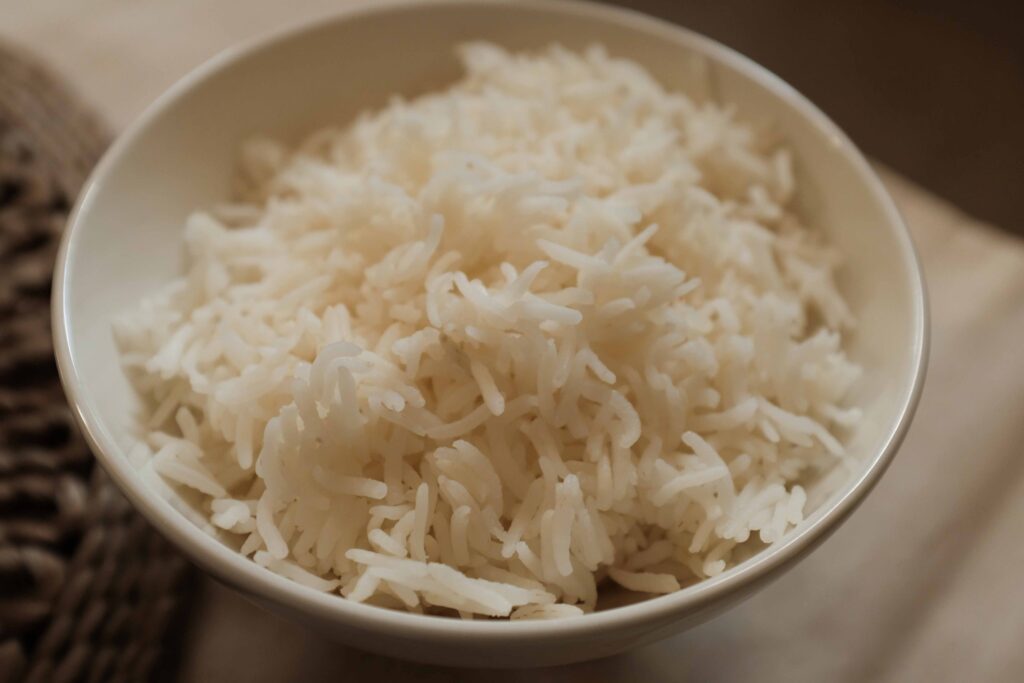Makes 4 servings.
Fish Alberas [uhl-bay-russ] is a signature dish of the Bene Israel; an Indian-Jewish community believed to have arrived in the 1st or 2nd century, after their ancestors were shipwrecked on the western coast of India. Influenced by Konkan cuisine and the Marathi tongue, the ‘al’ refers to ginger and the ‘ras’ refers to gravy*. Traditionally, layers of onion, potato, fish, and tomato are simmered in a gingery coconut broth and topped with coriander leaves. My version deconstructs the classic, rustic preparation and resurrects it as a modern, fine-dining experience—in celebration of my Bene Israel roots.
At a glance
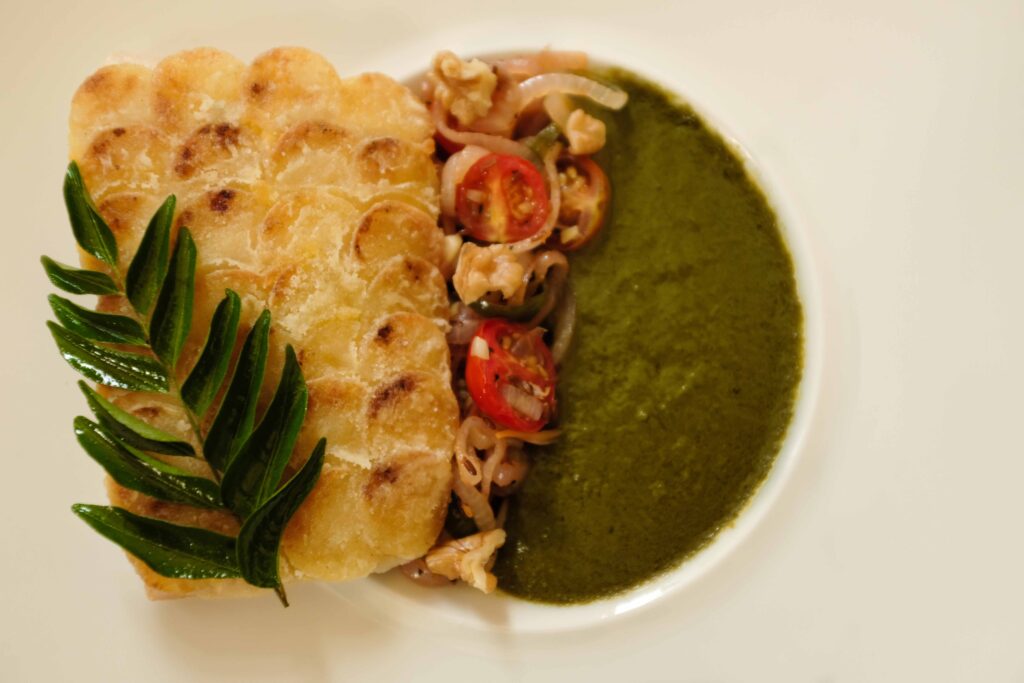
– This dish comprises green coconut sauce + onion & tomato salsa + potato-scaled fish + steamed rice
– You will need a medium skillet, a medium saucepan, and some baking parchment paper.
– This recipe has been broken into 5 stages for ease and comprehension. Please read the entire recipe from start to finish before beginning.
Stage 1: green coconut sauce

Ingredients
For the green paste:
1. 1 small red onion (roughly 50 gm)
2. 4 small cloves of garlic
3. 4 cm piece of fresh ginger
4. 3 cups packed fresh coriander, leaves and stems (roughly 100 gm)
5. 2 fresh green chillies
6. ½ a medium tomato
7. 3 inch piece green/raw mango, without the skin
8. ½ tsp salt
9. 1/4 tsp turmeric powder
10. ½ tsp Kashmiri red chili powder
11. 1 tsp coriander powder
12. ½ tsp cumin powder
13. 2 tbsp. water
For the coconut sauce:
14. 1 tbsp. cooking olive oil
15. 400 ml thick coconut milk
16. ½ tsp salt
17. 1 tsp jaggery powder
18. 2-3 wet kokum petals
Traditionally, this is the ‘ras’ part of the Fish Alberas, or coconut milk that is simmered with fresh green herbs and aromatics. In my version, I make a gingery, herbaceous, green paste (hara chutney) which will be slow simmered in thick coconut milk. The end consistency is more like a luscious, emulsified sauce, rather than a thin, runny gravy.
Prep
1 – Put all the ingredients listed in ‘for the green paste’ into a blender jar. Grind together until you get a smooth paste.
Method
1 – Place your saucepan on the stove and heat it on medium-high. Add the oil to the hot pan and then lower the flame.
2 – Add the green paste to the pan and fry it on low heat for 3-4 minutes or until the smell of raw onion, ginger, and garlic dissipates. Stir continuously so it doesn’t brown.
3 – Stir your coconut milk thoroughly so that it is homogenised. Add the coconut milk to the pan and bring the mixture to a simmer on medium-low heat.
4 – Lower the heat to minimum. Simmer the sauce for 25 minutes, stirring frequently to keep the sauce emulsified. Do not raise the heat or boil at any stage. You want a thick, homogenous, fresh-tasting sauce that is olive coloured.
5 – After 25 minutes, add the salt and the jaggery powder and stir. The sauce will thin slightly. Simmer it on low heat for 5 more minutes and then turn off the heat.
6 – Add 2-3 wet kokum petals to the hot mixture, cover the pan with a lid, and leave the petals to infuse in the hot sauce.
7 – When the sauce is cool, fish out the kokum petals with a fork and discard them. Your green coconut sauce is ready. Cover the pan with a lid and set it aside.
Stage 2: onion & tomato salsa
Ingredients
1. 1 tbsp. cooking olive oil
2. 1 tsp whole cumin seeds
3. 4 long green chillies, deseeded and julienned
4. 8 cm piece young ginger, julienned
5. 4 small cloves of garlic, finely sliced
6. 4-5 small red onions (roughly 200 gm)
7. 30 cherry tomatoes (roughly 200 gm)
8. 1 tsp salt
9. ½ tsp freshly cracked black pepper
This is the vegetables part of the Fish Alberas. Traditionally, the onions, potatoes and tomatoes are simmered and softened in the coconut milk. In my version, rather than stewing them, the veg is treated like a fresh salsa so that the onions and tomatoes retain their individual texture and flavour. I don’t recommend using mature ginger here. Young ginger is much milder, smells floral, and tastes wonderfully sweet and sour, which really accentuates the raw mango in the green paste. Where are the potatoes? Read the rest of the recipe to find out!
Prep
1 – Cut your 8 cm young ginger piece down the middle. Then slice it finely and julienne it. Finely slice your garlic cloves lengthwise.
2 – Cut your chillies in half and deseed them. Then julienne them. If your juliennes are really long, cut them into halves.
3 – Slice your onions into ½ cm rings and cut your cherry tomatoes into halves.
Method
1 – Place your skillet on the stove and heat it on medium-high. Add the oil to the hot skillet and then lower the flame.
2 – Throw in the cumin seeds and wait for them to crackle.
3 – Add the green chillies, ginger, and garlic to the skillet. Sauté on low for 1-2 minutes or until the raw smells dissipate.
4 – Raise the heat to medium-high and add the onion rings to the skillet. Fry them for 2-3 minutes until they’re lightly softened.
5 – Add the cherry tomatoes to the skillet and fry them on medium-high for 2 minutes or until lightly softened and blistered.
6 – Turn the heat off, season the mixture with salt and pepper, and quickly toss everything together while it’s still hot. This is your onion & tomato salsa. Set it aside.
Stage 3: potato-scaled fish
Ingredients
1. 4 boneless, skinless Indian Salmon (Rawas) fillets; each weighing 125-130 gm, cut into 12 cm x 6 cm rectangles, 2 cm thick.
2. 2 medium potatoes (roughly 250 gm)
3. 25 gm potato starch/corn flour
4. 2 tbsp. extra virgin olive oil
5. 1 egg yolk (divided among 4 fillets)
6. 2 tbsp. cooking olive oil for frying (divided among 4 fillets)
7. ½ tsp ground ginger (divided among 4 fillets)
8. Pinch of coarse sea salt, before and after frying (for each fillet)
This is the fish and potato layer of the dish. Fish is an important staple in Bene Israel households and is the star of the dish. I’ve found Fish Alberas recipes where sea fish like Pomfret and Croaker (Ghol) is used instead of Indian Salmon/King Threadfin/Rawas. Whichever fish you use, seek boneless, skinless fillets and avoid using river fish. Traditionally, the fish is added to the gravy, raw. Blame it on the Bengali in me, but I need to fry fish pieces before adding them to a curry; so I’ve changed things up! Potatoes are also fundamental to Fish Alberas. But rather than stewing and softening the potato in the coconut milk curry, I’ve gone into Gordon Ramsey MasterChef mode and made a ‘potato scales’ crust. There are 2 reasons for this; 1 – fish is only considered ‘kosher’ (satisfying Jewish food laws) if it comes from a creature that has visible fins and scales. While I am in no way adhering to kosher norms, this is a creative (and edible) way to showcase scales. And 2 – fried fish & potatoes for the win!
Prep
1 – Cut 4 pieces of baking parchment, about 3 cm larger (on all sides) than the length and breadth of your fillets.
2 – Ready your fish; pat your rawas fillets dry with some kitchen paper. Leave them to drain on the kitchen paper.
3 – Ready your scales; peel your potatoes and then cut them into 0.1 cm slices. I use a mandolin to make the slices, for speed and consistency. Then, using an apple corer or a cookie cutter, cut out 2 cm rounds from the slices. You will need about 28 potato rounds per fillet or 112 rounds for 4 fillets. These are your ‘scales’. In a medium bowl, mix 25 grams of potato starch with 2 tablespoons of extra virgin olive oil and mix well to form an oily paste. Toss the potato scales in and evenly coat them in this paste. Set aside.
Method
1 – Brush the top of one fillet with some egg yolk.
2 – Arrange the potato scales on the fillet (the egg will act as a glue), in an overlapping pattern to imitate fish scales. A tweezer is very useful for this. Repeat with the other 3 fillets.
3 – Place a rectangle of parchment on each fillet and then place the fillets in the fridge to chill for 30 minutes.
4 – After the fillets have chilled, things can get a little tricky because you can only fry one fillet at a time in one skillet. Take your fillet out of the fridge and remove the parchment. Sprinkle the scales with a pinch of coarse sea salt. Then put the baking parchment back on. Then lift up your fillet, holding the fish-side on your palm. The potato scale-side should be on top with the parchment covering it.
5 – Take your skillet in your other hand and turn it upside down. Place the fillet inside the inverted skillet from below, so that the parchment-side meets the skillet’s cooking surface. Make sure your piece of fish is right in the centre of the skillet for even cooking.
6 – While keeping your hand on the fillet to secure it, flip your skillet back to its normal side. Your fillet should now be safely in the pan, parchment-side down.
7 – Place your skillet on the stove and add ½ a tablespoon of oil to the skillet, making sure to drizzle it inside the parchment so it can reach the potato scales.
8 – Put the heat on under the skillet, setting it to high. As soon as you can see the potato scales frying, lower the heat to minimum. Fry the fillet, parchment-side down for 7-8 minutes.
9 – Slide your spatula under the parchment and very carefully flip the fillet so that it’s fish-side down. Remove the parchment; you should have beautifully even, golden brown potato scales. Fry the fillet, fish-side down for 1-2 minutes and then immediately turn off the heat and move your skillet to a cold hob.
10 – Season with a sprinkle of coarse sea salt and 1/8 teaspoon dusting of ginger powder.
11 – Repeat steps 4 through 9 with your other 3 fillets.
12 – After frying each fillet, transfer it to a warm oven (50-60OC). Keep all the fillets there as you finish up the dish.
When you’re cutting out your scales, you’ll be left with a lot of potato off-cuts. Do not throw them away! Store them in a bowl of water in the fridge. They can be deep fried later and taste as good as regular-looking potato chips.
Stage 4: steamed rice
Ingredients
1. 180 gm (1 cup) raw basmati white rice like this
2. 375 ml water (1 ½ cups)
Prep
1 – Wash your rice very well until the water runs clear. About 5-6 times.
2 – Soak your rice in plain water for no more than 30 minutes, else the grains will break.
Method
1 – After 30 minutes, drain the rice using a fine meshed strainer. Transfer the soaked and drained rice to a vessel with a tight fitting lid.
2 – Add the measured quantity of water to the rice, and no more.
3 – Place your vessel on the stove, uncovered, and start the heat on high. You want to bring the rice to a boil. When the water comes to a rolling boil, you should see some grains ‘dancing’ and steam holes forming in some areas. At this point, turn the heat to the lowest setting and place the lid on the vessel. I like to place some aluminium foil on the vessel and then pop the lid on, to trap all the steam.
4 – Let the rice cook on very low heat for exactly 11 minutes. If your stove burns hot, then place the vessel on a pre-heated cast iron skillet or tava and then put it on the heat.
5 – After 11 minutes, take the lid off and let the steam escape for 2 seconds, and then immediately pop the lid back on.
6 – Move the vessel to a cold hob and let it sit undisturbed for 6 minutes only.
7 – Remove the lid and gently fluff up the rice with a fork. Your perfectly steamed, fluffy rice is ready! Cover it loosely with aluminium foil and keep it aside while you move on to the next stage.
A lot of people struggle to make perfectly steamed rice on the stove top. It’s either too mushy/undercooked, or the grains break/grains dry out and burn. This method is easy, fast, and yields perfect results each time. Unlike the boil and strain method, you neither have to check the rice for doneness, nor drain the rice of excess water after it’s done. Please note, this method only works for medium-long grain Basmati rice and will not work for other rice varieties and types such as short, brown, sticky, parboiled, wild etc.
Stage 5: finishing touches, plating & serving
Components
1. Onion & tomato salsa
2. Potato-scaled fish
3. Green coconut sauce
4. 4 small curry leaf sprigs ( or 15-20 curry leaves without the stems)
5. 4 whole walnuts
6. 2 tbsp. cooking olive oil for frying
7. Steamed white rice
Prep
1 – Fry your curry leaves; Place oil in a skillet and heat on low. Fry the whole curry sprigs one at a time until they are dark green, glossy, and crispy. Transfer them to some kitchen paper to drain. This method is for ‘fancy plating’. You could just as well remove all the leaves from the stems, fry them together, and then top your salsa with the fried leaves during plating.
2 – Reheat your green coconut sauce. Apply gentle heat, as you don’t want the sauce to boil and separate.
3 – Reheat your salsa on high heat, for roughly 2 minutes.
4 – Reheat your rice if required.
5 – Take your fish out from the warm oven.
6 – Split your walnuts and then break them into rough kernels.
Method
To plate each individual serving of Fish Alberas, arrange the components in the following way —
1 – Place 1/4th of the onion & tomato salsa in a circular pile, just off-centre to the plate.
2 – Place the potato-scaled fish on top of the salsa.
3 – Pour 1/4th of the coconut sauce onto the plate, taking care not to get any on the fish itself.
4 – Scatter some broken walnut kernels onto the salsa.
5 – Arrange a fried curry leaf sprig on top of the fish, or top the salsa with 3-4 fried curry leaves.
6 – Serve your fancy-schmancy Fish Alberas with a side of steamed rice. If you’ve served your dish with whole curry leaf sprigs, remember to take the curry leaves off the stem and then eat (the stem is fibrous and inedible). Happy Hanukkah from my home to yours! Now eat!
Research & Citations
*As researched by Tara Deshpande in:
https://www.indiafoodnetwork.in/food-stories/bene-israel-lunch-zimra-israel/
http://www.taradeshpande.in/bene-israel-fish-alberas-by-zimra-israel/
Further research:
https://www.goya.in/blog/the-fascinating-cuisine-traditions-of-the-bene-israelis-of-india-book-of-rachel
https://lifestyle.livemint.com/food/discover/how-diaspora-communities-made-the-fish-of-the-konkan-their-own-111601964545384.html
https://www.seema.com/meet-one-of-the-oldest-indian-jewish-groups/
Inspiration:
Classic Fish Alberas by Zimra Israel:
Gordon Ramsay’s Potato-Crusted Sea Bass with Minestrone and Clams, from Masterchef Australia 2019:

